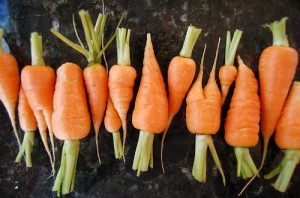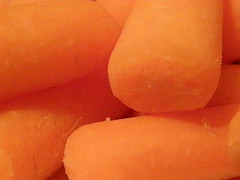We eat a lot of baby carrots at our house. They are a simple, healthy, ready-to-eat snack when we are on the run. Those little mini carrots travel with us to baseball fields, on airplanes and in our lunch boxes.
Recently an email about baby carrots, that’s been circulating for a few years, was forwarded to my inbox.
Here’s a summary of the email:
- The small cocktail (baby) carrots you buy in small plastic bags are made using the larger crooked or deformed carrots which are put through a machine which cuts and shapes them into cocktail carrots
- Once the carrots are cut and shaped into cocktail carrots they are dipped in a solution of water and chlorine in order to preserve them (this is the same chlorine used in your pool).
- Since they do not have their skin or natural protective covering, they give them a higher dose of chlorine.
- The white covering that forms on carrots that have been in the refrigerator for a few days is the chlorine which resurfaces.
The email also states that the information has been confirmed by snopes.com, a site that checks on the validity of urban legends.
I had to see for myself, so I went straight to snopes.com and as it turns out there is a mixture of true and false information in the email.
Here is the low down for all you baby carrot fans
- The World Carrot Museum (yes, there really is a World Carrot Museum) explains that there are two types of baby carrots-real baby carrots, and manufactured baby carrots. A “true” baby carrot is a carrot grown to the “baby stage”. Manufactured carrots are carrot shaped slices of regular sized peeled carrots.
- You can tell what type of carrot you are buying by looking at the packaging. If the bag says “baby carrots” they are true baby carrots. If it is labeled “baby cut carrots” then they are made by cutting down and peeling the bigger version of the carrot.
- Baby carrots are not as nutritious as full whole carrots because a lot of the nutrition in carrots is contained in the skin and just below it. This is removed in the baby carrot making process.
- Baby-cut carrots and many other bagged, ready-to-eat, fresh veggies are rinsed or sprayed with diluted chlorine to reduce the risk of bacterial contamination, and then thoroughly washed and bagged. The time of contact between the carrots and the chlorinated water should not exceed 5 minutes. The chlorine is then removed from the carrots through more rinsing. The FDA has approved this process. It is the same chlorine found in your tap water-the water many of us use to rinse off vegetables before eating. It is not the same concentration used in your pool-but it is chlorine. Many organic growers use a citrus based solution called Citrox-a supposedly safe, natural alternative, to rinse fruits and veggies instead of chlorine.
- The “white covering” which sometimes appears on the surface of refrigerated carrots is called “white blush” in the industry. My son’s leftover cut up carrots come home at the end of the day with a white film. It’s a harmless discoloration resulting from dehydration-not chlorine.
Bottom line: Most baby carrots are regular carrots cut into the shape of baby sized carrots. Baby carrots are slightly less nutritious than their larger version. Carrots and all ready-to-eat foods are generally washed with chilled, lightly chlorinated water, rinsed and then packaged. This procedure is in compliance with FDA regulations.
Now you have to decide if chlorine exposure bothers you. If yes, buy regular, organic, full sized carrots with the peel on. If you want to reap the full nutritional value of the carrot, wash regular carrots well with filtered water and eat with the peel on. Using your regular tap water will also expose your carrots to some chlorine. Best bet-grow your own carrots and wash with filtered water.
Personally, I am not willing to add any unnecessary chlorine into my body-even if it is an amount said to be safe by the FDA. I am diligent about filtering my water to remove chlorine-both in the sink and the shower. I am also dumping organic baby cut carrots rinsed with the supposedly safe Citrox. I really have no idea what Citrox is-the information seems very vague. So bye-bye baby carrots-you have been taken off my Thanksgiving menu.
Happy Thanksgiving
Spread the love. Please share this post with your friends. And please become a FACEBOOK fan. Thanks!
sources and resources:
Carrot Vending Machines a Surprise Success


